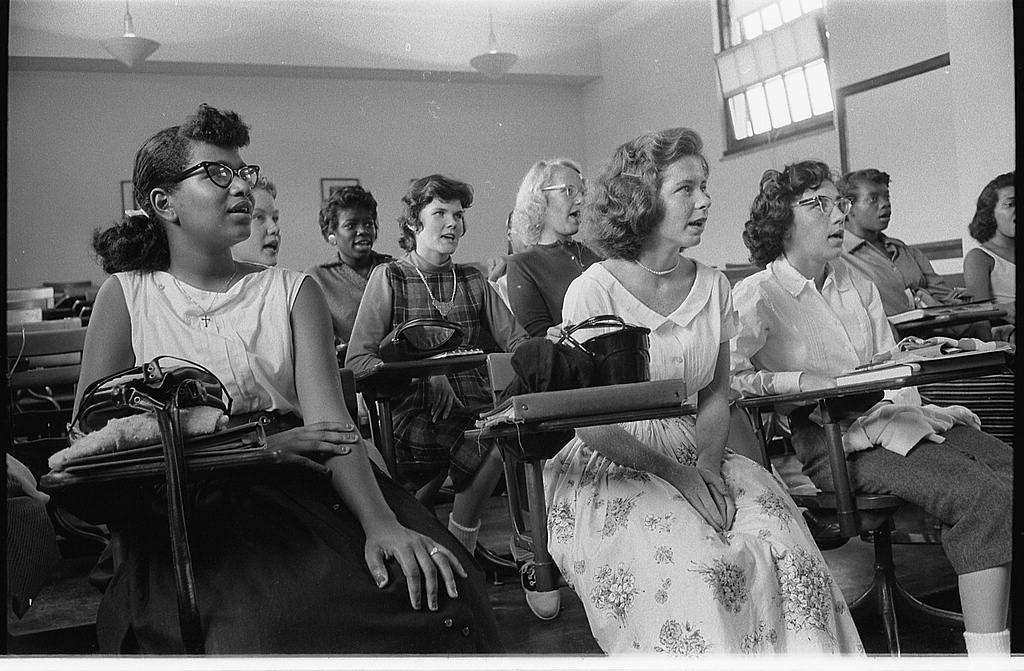Introduction: Desegregation
Students at Anacostia High School September 10, 1957, three years after the Supreme Court’s ruling in the Bolling v. Sharpe case that outlawed school segregation in the District of Columbia. By Warren K. Leffler, Library of Congress
Throughout U.S. history, communities of color have fought for their right to equal access and for human dignity and equity. Desegregation in public schools, transportation, and other accommodations involved more than court cases and legal victories. Desegregation was a long (and ongoing) struggle led by students, parents, and everyday citizens who experienced or saw the injustice of U.S. segregation. Faced by indignities and violence, students and parents maintained the courage to fight for the rights of first-class citizenship.
They were not interested in integration, or the desire to mingle socially or otherwise with whites, but to break and reconstruct institutions that forced people of color into positions of poverty, illiteracy, and political powerlessness. As Charles Payne states in “The View from the Trenches”:
“White supremacy” is a more accurate description of what the system was about. “Segregation” is the way apologists for the South liked to think of it. It implies, “We’re not doing anything to Black people; we just want to keep them separate from us.” It was the most innocent face one could put on that system. When we use the term as a summary term for what was going on in the South, we are unconsciously adopting the preferred euphemism of 19th-century white supremacist leadership.
If “segregation” is a poor way to describe the problem, “integration” may not tell us much about the solution. It is not at all clear what proportion of the Black population was interested in “integration” as a general goal. African Americans have wanted access to the privileges that white people have enjoyed and have been interested in integration as a possible avenue to those privileges, but that view is different from seeing integration as important in and of itself.
While segregation did not occur uniformly across the United States, the denial of equal access to public accommodations had everything to do with race, ethnicity, and national origin. Public accommodations are those spaces and resources intended for all members of society, particularly for those that are supported by taxpayers. The experiences of Latinx and Hispanic communities in California, New Mexico, and other parts of the Southwest; the formation of Indian reservations; redlining; and Jim Crow all demonstrate the deliberate segregation of communities of color in U.S. life. In many cases, Native, Latinx, and Asian communities were classified with Black people and excluded from so-called “white” facilities, to maintain and promote white supremacy. This was also the case in the North, as Thomas J. Sugrue eloquently describes in Sweet Land of Liberty: The Forgotten Struggle for Civil Rights in the North.
Rosa Parks is often heralded as the first person to challenge Jim Crow transportation. Others note that teenager Claudette Colvin preceded her. While both women took brave actions, the history of resistance is much longer. Twenty years before the start of the Civil War and another one hundred years before the Montgomery Bus Boycott, Frederick Douglass and his friend James Buffum refused to leave a segregated car in 1841. Their refusal inspired similar actions that, temporarily, granted equal rights for Black citizens in public accommodations. Our Transportation Protests timeline offers students dozens more examples of individuals who challenged segregation in public transportation, such as Ida B. Wells, Elizabeth Jennings, Maggie Lena Walker, Pauli Murray, and Jackie Robinson. There are hundreds more stories in Traveling Black: A Story of Race and Resistance by Mia Bay.
Before the Brown v. Board of Education decision in 1954, the Lemon Grove case in 1930 and the Mendez v. Westminster School District case in 1947 challenged segregation in education. The Mendez case was brought by five families who were unwilling to accept second-class citizenship for their children. Scholarship on Native American history, such as Denise E. Bates’ book, The Other Movement: Indian Rights and Civil Rights in the Deep South, has brought to light the political mobilization of Native American communities and the role of intertribal state commissions in the U.S. South after World War II. Even before the 20th century, as David Adams shows in Education for Extinction: American Indians and the Boarding School Experience, 1875-1928, Native American students pushed back against government schools through acts of resistance.
In this section, we provide a mythbuster quiz, lessons, poetry, and readings on the long and ongoing fight for equal access with an emphasis on the role of young people. ■

